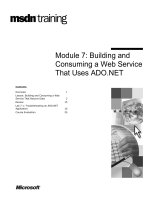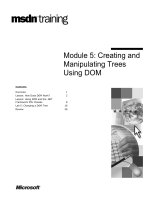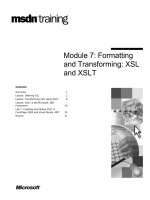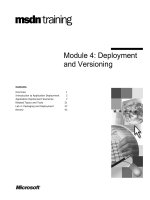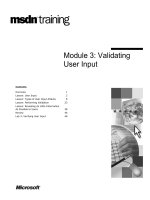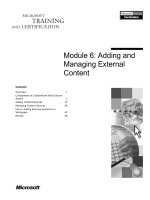Tài liệu Module 09 Viruses and Worms doc
Bạn đang xem bản rút gọn của tài liệu. Xem và tải ngay bản đầy đủ của tài liệu tại đây (5.58 MB, 136 trang )
Ethical Hacking and
Countermeasures
Version 6
Mod le IX
Mod
u
le IX
Viruses and Worms
News
EC-Council
Copyright © by EC-Council
All Rights Reserved. Reproduction is Strictly Prohibited
Source:
Scenario
Ricky, a software professional with a
reputed organization received a mail
reputed organization
,
received a mail
which seemed to have come from some
charitable organization. The mail was
havin
g
a .
pp
t attachment with name
gpp
“demo of our charity work”. Just
before leaving for his home he
downloaded and played the attached
presentation. The presentation
consisted of images of poor people
being served.
What could be the dangers of opening an attachment from
unknown source?
EC-Council
Copyright © by EC-Council
All Rights Reserved. Reproduction is Strictly Prohibited
What could be the losses if attachment that Ricky opened
had viruses or worms?
Module Objective
This module will familiarize you with :
•Virus
• History of Virus
• Different characteristics and t
yp
es of virus
yp
• Basic symptoms of virus-like attack
• Difference between Virus and Worm
•Virus Hoaxes
• Indications of virus attacks
• Basic working and access methods of virus
• Various damages caused by virus
•
Life cycle of virus
•
Life cycle of virus
• Virus Infection
• Various virus detection techniques
•
Top ten virus of 2005
EC-Council
Copyright © by EC-Council
All Rights Reserved. Reproduction is Strictly Prohibited
Top ten virus of 2005
• Virus incident response
Module Flow
Virus
Characteristics and
T f i
S
y
m
p
toms of Virus attack
T
ypes
o
f
v
i
rus
yp
Access methods of virus Indications of Virus Attack Virus Hoaxes
Life cycle of virus Virus Infection
Writing a sample Virus code
Virus Detection and Defenses
Anti
-
Virus Software
Virus incident response
EC-Council
Copyright © by EC-Council
All Rights Reserved. Reproduction is Strictly Prohibited
Virus Detection and Defenses
Anti
Virus Software
Virus incident response
Introduction to Virus
Computer viruses are perceived as a threat to both business and personnel
Computer viruses are perceived as a threat to both business and personnel
Virus is a self-replicating program that produces its own code by attaching copies of
it lf i t th t bl d
it
se
lf i
n
t
o
o
th
er
execu
t
a
bl
e
co
d
es
Operates without the knowledge or desire of the computer user
Operates without the knowledge or desire of the computer user
EC-Council
Copyright © by EC-Council
All Rights Reserved. Reproduction is Strictly Prohibited
Virus History
Year of
Discover
y
Virus Name
y
1981 Apple II Virus- First Virus in the wild
1983
First Documented Virus
d
1986 Brain, PC-Write Trojan, & Vir
d
em
1989
AIDS Trojan
1995
Ct
1995
C
oncep
t
1998 Strange Brew & Back Orifice
1999
Melissa, Corner, Tristate, & Bubbleboy
1999
Melissa, Corner, Tristate, & Bubbleboy
2003 Slammer, Sobig, Lovgate, Fizzer, Blaster/Welchia/Mimail
2004 I-Worm.NetSky.r, I-Worm.Baqle.au
EC-Council
Copyright © by EC-Council
All Rights Reserved. Reproduction is Strictly Prohibited
2005 Email-Worm.Win32.Zafi.d, Net-Worm.Win32.Mytob.t
Characteristics of a Virus
Virus resides in the memory and replicates itself while the
program where it is attached is running
program where it is attached is running
It does not reside in the memory after the execution of the
program
It can transform themselves by changing codes to appear
different
It hides itself from detection by three
ways:
• It encrypts itself into the cryptic symbols
• It alters the disk directory data to compensate the
dditi l i b t
EC-Council
Copyright © by EC-Council
All Rights Reserved. Reproduction is Strictly Prohibited
a
dditi
ona
l
v
i
rus
b
y
t
es
• It uses stealth algorithms to redirect disk data
Working of Virus
Trigger events and direct attack are the common modes which cause a virus to “go off” on a
target system
Most viruses operate in two phases:
If ti Ph
• Virus developers decide when to infect the host system’s programs
• Some infect each time they are run and executed completely
• Ex: Direct Viruses
I
n
f
ec
ti
on
Ph
ase:
• Some virus codes infect only when users trigger them which include a
day, time, or a particular event
• Ex: TSR viruses which get loaded into memory and infect at later
stages
• Some viruses have trigger events to activate and corrupt systems
• Some viruses have bugs that replicate and perform activities like file
deletion and increasing the session time
Attack Phase:
EC-Council
Copyright © by EC-Council
All Rights Reserved. Reproduction is Strictly Prohibited
deletion and increasing the session time
• They corrupt the targets only after spreading completely as intended by
their developers
Working of Virus: Infection
Phase
Phase
Attaching .EXE File to Infect the Programs
EXE File
EXE File
Before
Infection
After
Infection
File HeaderFile Header
IP IP
.
EXE
File
.
EXE
File
Start of
Program
Start of
Program
End of ProgramEnd of
Program
EC-Council
Copyright © by EC-Council
All Rights Reserved. Reproduction is Strictly Prohibited
Virus Jump
Working of Virus: Attack Phase
Slowdown of PC due to Fragmented Files
Page: 3
Page: 2
Page: 1
Page: 3
Page: 2
Page: 1
Unfragmented File Before Attack
File: A File: B
Page:
3
Page:
2
Page:
1
Page:
3
Page:
2
Page:
1
P1
P3
P1
P2
P2
P3
File Fragmentation Due to Virus Attack
P
age:
1
File: B
P
age:
3
File: B
P
age:
1
File: A
P
age:
2
File: A
P
age:
2
File: B
P
age:
3
File: A
EC-Council
Copyright © by EC-Council
All Rights Reserved. Reproduction is Strictly Prohibited
Source: www.microsoft.com
Why People Create Computer
Viruses
Viruses
V
irus writers can have various reasons for creatin
g
and
g
spreading malware
•
Research projects
Viruses have been written as:
•
Research projects
•Pranks
•Vandalism
• To attack the products of specific companies
T di ib h lii l
•
T
o
di
str
ib
ute
t
h
e
po
li
t
i
ca
l
messages
• Financial gain
•Identity theft
•S
py
ware
EC-Council
Copyright © by EC-Council
All Rights Reserved. Reproduction is Strictly Prohibited
py
• Cryptoviral extortion
Symptoms of Virus-Like Attack
If the system acts in an unprecedented manner, you can suspect a virus attack
• Example: Processes take more resources and are time consuming
However, not all glitches can be attributed to virus attacks
•Examples include:
Cti hd bl
•
C
er
t
a
i
n
h
ar
d
ware
pro
bl
ems
• If computer beeps with no display
• If one out of two anti-virus programs report virus on the system
• If the label of the hard drive change
•
You
r
co
m
pute
r
fr
ee
z
es
fr
eque
n
t
l
y o
r
e
n
cou
n
te
r
s e
rr
o
r
s
ou co pute ee es eque t y o e cou te s e o s
• Your computer slows down when programs are started
• You are unable to load the operating system
• Files and folders are suddenly missing or their content changes
• Your hard drive is accessed often (the light on your main unit flashes rapidly)
flf
EC-Council
Copyright © by EC-Council
All Rights Reserved. Reproduction is Strictly Prohibited
•Microso
f
t Internet Exp
l
orer "
f
reezes"
• Your friends mention that they have received messages from you but you never sent such messages
Virus Hoaxes
Hoaxes are false alarms claimin
g
re
p
orts about a non-existin
g
gp
g
v
irus
Warnin
g
messa
g
es
p
ro
p
a
g
atin
g
that a certain email messa
g
e
ggppgg g
should not be viewed and doing so will damage one’s system
In some cases, these warnin
g
messa
g
es themselves contain
gg
v
irus attachments
They possess capability of vast destruction on target systems
They possess capability of vast destruction on target systems
Being largely misunderstood, viruses easily generate myths.
Most hoaxes while deliberately posted die a quick death
EC-Council
Copyright © by EC-Council
All Rights Reserved. Reproduction is Strictly Prohibited
Most hoaxes
,
while deliberately posted
,
die a quick death
because of their outrageous content
Virus Hoaxes (cont’d)
EC-Council
Copyright © by EC-Council
All Rights Reserved. Reproduction is Strictly Prohibited
Chain Letters
EC-Council
Copyright © by EC-Council
All Rights Reserved. Reproduction is Strictly Prohibited
Worms
Worms are distinguished from viruses by the fact that a virus requires some
f f th h i t ti t i f t t h d t
f
orm
o
f th
e
h
uman
i
n
t
erven
ti
on
t
o
i
n
f
ec
t
a
compu
t
er
w
h
ereas
a
worm
d
oes
no
t
Source:
/>worm/ddos2.gif
EC-Council
Copyright © by EC-Council
All Rights Reserved. Reproduction is Strictly Prohibited
How is a Worm different from a
Virus
Virus
There is a difference between general viruses
and worms
A worm is a special type of virus that can
replicate itself and use memory, but cannot
h i lf h
attac
h i
tse
lf
to
ot
h
er
programs
A
worm spreads through the infected network
automatically but a virus does not
EC-Council
Copyright © by EC-Council
All Rights Reserved. Reproduction is Strictly Prohibited
Indications of Virus Attack
I di ti f i tt k
• Programs take longer to load than normal
Computer's hard drive constantly runs out of free space
I
n
di
ca
ti
ons
o
f
a
v
i
rus
a
tt
ac
k
:
•
Computer's hard drive constantly runs out of free space
• Files have strange names which are not recognizable
• Programs act erratically
•
Resources are used up easily
•
Resources are used up easily
EC-Council
Copyright © by EC-Council
All Rights Reserved. Reproduction is Strictly Prohibited
Hardware Threats
Power Faults:
• Sudden power failure, voltage spikes, brownout and frequency shifts cause damage to system
System Life:
•
Syste
m
gets
w
o
rn-
out ove
r
a pe
ri
od o
f
t
im
e
Syste gets o
out ove a pe od o t e
Equipment Incompatibilities:
• These occur due to improperly installed devices
Typos:
• Data gets corrupted due to deletion or replacement of wrong files
Accidental or Malicious Damage:
Accidental or Malicious Damage:
• Data gets deleted or changed accidentally or intentionally by other person
Problems with Magnets:
EC-Council
Copyright © by EC-Council
All Rights Reserved. Reproduction is Strictly Prohibited
• Magnetic fields due to floppy disk, monitor, and telephone can damage stored data
Software Threats
Software Problems:
• In multitasking environment, software conflicts may occur due to sharing of data by all
running programs at the same time
Th b d f i f ti d t i l t f d t i
•
Th
ere
may
b
e
d
amage
o
f i
n
f
orma
ti
on
d
ue
t
o
m
i
sp
l
acemen
t
o
f d
a
t
a
i
n
a
program
Software Attacks:
• Intentionally launched malicious programs enable the attacker to use the computer in
an unauthorized manner
• General Categories:
•
Viruses and worms
•
Viruses and worms
•Logic bombs
•Trojans
EC-Council
Copyright © by EC-Council
All Rights Reserved. Reproduction is Strictly Prohibited
Virus Damage
Virus damage can be grouped broadly under:
• The technicalities involved in the modeling and use of virus causes damage due to:
•Lack of control
•
Difficulty in distinguishing the nature of attack
Technical Attributes:
•
Difficulty in distinguishing the nature of attack
• Draining of resources
• Presence of bugs
• Compatibility problems
• There are ethics and legalities that rule why virus and worms are damaging
Ethical and Legal Reasons:
Ps
y
cholo
g
ical Reasons: These are:
•Trust Problems
• Negative influence
• Unauthorized data modification
• Issue of Copyright
yg
EC-Council
Copyright © by EC-Council
All Rights Reserved. Reproduction is Strictly Prohibited
• Misuse of the virus
• Misguidance by virus writers
Modes of Virus Infection
Viruses infect the system in the
Viruses infect the system in the
following ways:
• Loads itself into memory and checks for
executables on the disk
• Appends the malicious code to a legitimate
b k t t th
program
un
b
e
k
nowns
t t
o
th
e
user
• Since the user is unaware of the replacement,
he/she launches the infected program
•
As a result of the infected program being executes,
As a result of the infected program being executes,
other programs get infected as well
• The above cycle continues until the user realizes
the anomaly within the system
EC-Council
Copyright © by EC-Council
All Rights Reserved. Reproduction is Strictly Prohibited
Stages of Virus Life
Computer virus involves various stages right from its design to elimination
Design
Developing virus code using programming
languages or construction kits
Replication
Launch
It gets activated with user performing certain actions
like triggering or running a infected program
Virus first replicates for a long period of time within the
target system and then spreads itself
Launch
Detection
A virus is identified as threat
infecting target systems
like triggering or running a infected program
Incorporation
Elimination
Users are advised to install anti-virus
fdhi
Anti-virus software developers assimilate
defenses against the virus
EC-Council
Copyright © by EC-Council
All Rights Reserved. Reproduction is Strictly Prohibited
so
f
tware up
d
ates t
h
us creat
i
ng
awareness among user groups
T f Vi
T
ypes
o
f Vi
ruses
EC-Council
Copyright © by EC-Council
All Rights Reserved. Reproduction is Strictly Prohibited
